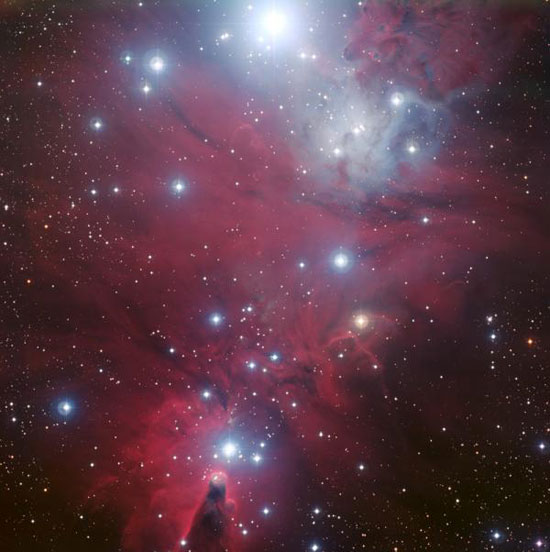Stars sparkle through photos
NGC 2264 is located 2,600 light-years from Earth in the faint constellation Unicorn of Monoceros, not far from the familiar Hunter constellation of Orion. The image shows a wide area of space about 30 light-years away.
William Herschel discovered this admirable object in his survey of the sky in the late 18th century. He first noticed a bright star cluster in January 1784, and the brightest part of this dim space. on Christmas two years later. The cluster is very bright and can be easily observed with a group of tubes. With a small telescope (the lens will cause the image to turn upside down), the stars look like glittering lights from the Christmas tree. The top star is so bright that it can be seen with the naked eye.This is a very large star system that emerged from dust and gas several million years ago.
Like star clusters, there are many interesting and strange structures in the clouds of gas and dust. At the bottom of the photo, the dark triangle is the Cone Nebula, the area of molecular gas illuminated by the brightest stars of the star cluster. The area to the left of the brightest star has a strange long-like texture and is named the Fox Fur Nebula.

The color image of the region known as NGC 2264 - a space of stars with sparkling blue stars in the cluster of Christmas Tree - is made from data collected by Wide Field Imager 4. Different filters (B, V, R and H-alpha) at ESO's La Silla Observatory, located above 2400 sea level in chile's Atacama Desert.This photo shows a 30-light-year area of space.(Photo: ESO)
Most of the picture is red because of the colorful giant gas clouds under ultraviolet light from energetic young stars . Stars are green, because they are hotter, younger and larger than our Sun. Some of this blue light suffers from molecular dust like the upper part of the photo.
This fascinating space is the ideal object for the study of star formation.The entire area is a small part of a giant cloud of molecular gas in the process of forming the next generation of stars. Outside of interesting objects in the photo, many other objects are covered by clouds. The area between the top of the Cone Nebula and the brightest star above the image is where the stars are formed. There is evidence of strong winds from these young "stars".
The image of NGC 2264, including the Christmas Tree Star Cluster, was Wide Field Imager (WFI), a dedicated astronomical camera attached to a 2.2-meter telescope Max-Planck Society / ESO at La observatory. Chilean Silla, done. Located at 2400m above sea level in the mountains of the Atacama Desert, ESO's La Silla observatory has the clearest and darkest sky in the world, making it the best place to study the deepest places of Space. To make this photo, WFI observed the cluster for more than 10 hours through a variety of dedicated filters to create a full-color image of a fluorescent fluorescent cloud.
- Why is the star sparkling?
- Breathtaking the sight of the stars 'circus' in the sky
- Decoding hobbies for nude photos
- Admire 20 animal stars
- 9 interesting things about stars
- Actual photos of two stars are eating each other
- Explain the mystery of missing stars in the universe
- Decoding super-fast stars in 'Ngan river'
- Detects 5 oversized stars on galaxies
- The bubble froze in the sunlight
- Dark Star - Gift from the Universe
- The software helps identify stars on photos
 Van Allen's belt and evidence that the Apollo 11 mission to the Moon was myth
Van Allen's belt and evidence that the Apollo 11 mission to the Moon was myth The levels of civilization in the universe (Kardashev scale)
The levels of civilization in the universe (Kardashev scale) Today Mars, the sun and the Earth are aligned
Today Mars, the sun and the Earth are aligned The Amazon owner announced a secret plan to build a space base for thousands of people
The Amazon owner announced a secret plan to build a space base for thousands of people